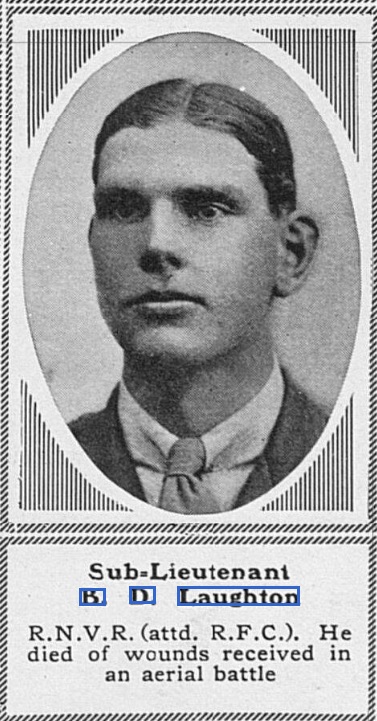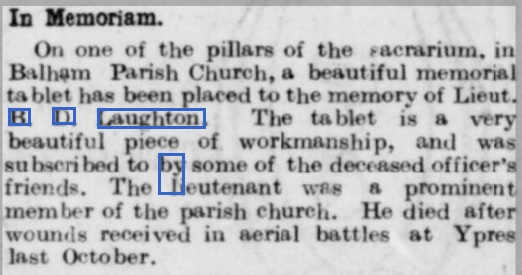- See Bertram Douglas Laughton’s entry on the Board of Trade’s Ancestry public tree.
- This information updates the group’s previous research published on the former DTI website (now archived by the National Archives).
- Do you have any more information about Bertram Douglas Laughton? If so the War Memorial Research Group would love to hear from you
Name recorded on Board of Trade Memorial: B. D. Laughton
Born: October 1894, Tonbridge, Kent, England
Date of Death: 1 October 1917
Age at death: 23
Service, Regiment, Corps, etc: Royal Naval Volunteer Reserve
Unit, Ship, etc: Hawke Battalion, Royal Naval Division and previously Queen Victoria’s Rifles
Enlisted: 2 September 1914
Rank: Sub Lieutenant (Service No: RND 695)
Decorations: WW1 Service Medals (Victory Medal and British War Medal)
War (and theatre): WW1 (France and Flanders)
Manner of Death: Died of Wounds (DOW)
Family Details: Son of Elizabeth J Laughton, 17 Crescent Grove, Clapham, London and late Thomas S Laughton
Residence:
Home Department: Board of Trade – Companies Department (High Court)
Civilian Rank: Personal Clerk
Cemetery or Memorial: Mendinghem Military Cemtery, Poperinghe, Belgium (VI.C.39); Board of Trade War Memorial; WW1 Memorial Tablet in St Mary and St John the Divine Church, Balham
Biography:

Of only we could hear voices from the past as well as read past stories and words on the page. In the case of Bertram Douglas Laughton, who was a talented musician who trained at Trinity College of Music it would be fascinating to hear his voice
Bertram Douglas Laughton was born in about October 1894 in Tonbridge, Kent. His parents were Thomas Stothard Laughton (1861-1912) and Elizabeth Jane Nash (1857-1936).
He had three sisters – Maude Evelyne Laughton (1885-1952), Blanche Ethel Laughton (1889-1954) and Gertrude Trissie Laughton (1899-1943) and a brother called Percy Stothard Laughton (1891-1972).
In the 1901 census, the Laughton family are living at 38 Klondike Road, Streatham (although his father is not listed at the address). Bertram is aged only 7. In the 1911 census the Laughton family are now living at 28 Dinsmore Road, Balham and Elizabeth is named as a “boarding house keeper”. Bertram is now aged 17 and working as a Clerk for the United Empire Club which was an exclusive gentleman’s club located on Piccadilly in 1904.

Bertram was subsequently appointed to the Companies Department in the Board of Trade where he worked as a Personal Clerk.
Besides his work, we also know from the Streatham News dated Friday 12 October 1917 reporting his death that Bertram was involved in the life of St Mary’s Church, Balham “and was one of the most respected members of the choir. There, from the vicar to the youngest choir-boy, he will be much missed for he was always a good churchman and loyal friend. He was a musician of a high order, having first studied under Mr Robert Percival of Upper Tooting. He afterwards gained a scholarship at Trinity College of Music, when his training was in the hands of the late Charles Copland. He sang several times at the Winter Gardens, Bournemouth, and many other well-known concert halls“.
On the outbreak of WW1, we know from a newspaper article reporting his death, that Bertram Laughton immediately enlisted as a Private in the 9th (County of London) Battalion, London Regiment (Queen Victoria’s Rifles) where he rose to become a Sergeant. Then in August 1915 he was commissioned into the Royal Naval Volunteer Reserve as a Sub-Lieutenant in the Royal Naval Division and was posted to the ship “Victory”.
After 15 months training in England, he was sent, at his own request to the front on 30 November 1916. We also know that he took part in the Battle of Ancre (February 1917) and the Battle of Arras (April 1917) and successfully captured a German machine-gun.
During this time in 1917, he was also reported wounded (shell shock) on either 23 January or 18 February 1917, rejoining his unit on 1 March 1917 (“no action taken as a casualty”).
Then on 8 August 1917 he transferred into the Royal Flying Corps (RFC) and after training in England was posted for active overseas service to No 7 Squadron on 23 September 1917. During the short period of flying, he took part in a number of aerial battles over the Ypres battlefields.
He was reported “dangerously wounded” on 1 October 1917 after crashing the Royal Aircraft Factory R.E.8 plane that he was flying and then “died of wounds” the same day (B D Laughton, RNVR Service Record, PRO, ADM 337/113).
A Board of Trade list of April 1918 records that Laughton died from wounds “while attached to the Royal Flying Corps”. He appears in the RNVR Roll of Honour as “Sub-Lieutenant RNVR attached to RFC” and, according to Murphy’s Register (ref 171208 page 209), he is listed, with a photograph, in “The Roll of Honour” lists published in Sphere on Saturday 8 December 1917.
Bertram is buried in Mendinghem Military Cemetery, Poperinghe, Belgium. The cemetery was located at Proven just north of Ypres near to where there were a number of casualty clearing stations during WW1. “Mendinghem” was a humourous popular name invented by British soldiers along with “Bandaghem” and “Dozinghem” and these names don’t actually appear associated with any local place names on modern day maps. The earliest burials took place in August 1916 with the last being in September 1918. There are now 2,391 Commonwealth WW1 graves at the cemetery as well as 52 German war graves.

He is also commemorated by the Board of Trade War Memorial in London. In his local area of Balham, Bertram is remembered by a memorial tablet in St Mary and St John the Divine Church, Balham in recognition of his close connection to the church (according to the Streatham News, 18 May 1918).

At the time of his death, his Squadron Commander paid this glowing tribute to Bertram: “During his time with the squadron he had shown great promise and in a fight recently behaved with the greatest determination and courage. He was just the type for an observer, very quiet and modest, but extraordinarily keen on his work, and would have turned out extremely well.“
